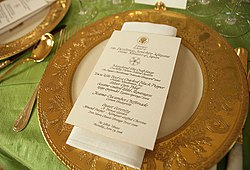Official invitations
The design of White House invitations has evolved over time. Dinner invitations going back to the administration of John Adams, the first president to live in the White House, are archived and have inspired the current invitations. In President Adams' day invitations were letterpress printed with the passage reading "The President of the United States, requests the Pleasure of ______'s Company to Dine, on_____next at ___ o'Clock." Space allowed for the hand-penned insertion of "& Mrs. Adams" if the first lady was to attend, as well as individual guests' names, and the date and time. [2] A flowing round hand type of penmanship was used. This style of writing was found in writing manuals in the 18th century.
The custom of including a representation of the arms of the United States, by way of an eagle clutching an olive branch and arrows in its talons and a striped shield with stars, became standard on invitations in the early 19th century. By the mid-19th century, the more formal Great Seal of the United States was placed at the head of invitations. The text was engraved in black script, allowing space for the guest's name to be added individually. The Great Seal was engraved in burnished gold.
In 1880, President Rutherford B. Hayes had a new seal created for the presidency. The new seal of the president of the United States shared similarities with the nation's Great Seal. Initially, the new presidential seal was applied to seal documents and the presidential flag. In 1902, President Theodore Roosevelt had the presidential seal applied to stationery and invitations in lieu of the Great Seal. The style of invitations became codified with few changes to the present.
This page is based on this
Wikipedia article Text is available under the
CC BY-SA 4.0 license; additional terms may apply.
Images, videos and audio are available under their respective licenses.







